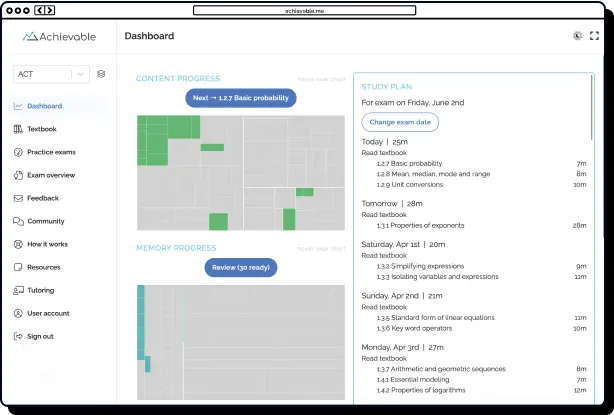
Which colleges superscore the SAT and ACT?




Table of contents
- SAT and ACT scoring basics
- What is an ACT/SAT superscore?
- How SAT Score Choice™ differs from SAT superscores
- Top colleges that superscore the ACT/SAT
- How many times should I take the ACT/SAT?
- When is the best time to take the ACT/SAT?
- When do ACT/SAT scores come out?
- When is the best time to send ACT/SAT scores?
- How can I improve my ACT/SAT superscore?
- Key takeaways
Did you know that more than half of students choose to retake the SAT to improve their scores? There’s a common misconception that taking undergraduate entrance exams more than once reflects badly on college applications. However, this is refuted by the fact that many institutions practice “superscoring,” encouraging students to take exams multiple times if needed. Colleges that superscore allow applicants to submit scores from multiple SAT or ACT sittings so that only their highest section scores are considered, helping applicants showcase their strongest results.
Superscoring is the process colleges use to create a composite SAT or ACT score by combining each student’s best section scores from different test dates. This policy enables students to focus on maximizing individual section scores, making it possible to target improvement in reading, math, or science as needed.
For students aiming for top results, particularly in colleges that offer ACT or SAT superscoring, it opens the door to significant score gains without penalty for multiple testing. While many schools embrace superscoring, it’s important to note that a handful of colleges do not superscore standardized exams, so understanding college scoring policies can help inform your test strategy.
Superscoring remains an excellent option for increasing your chances at admission, especially when you want your best scores to stand out.
SAT and ACT scoring basics
Before exploring SAT and ACT superscore conventions and how they can impact your college applications, it’s crucial to understand the fundamental differences in ACT scoring and the SAT score range.

The ACT is a standardized examination widely used for undergraduate admissions, evaluated on a scale from 1 to 36. The ACT assesses three primary subject areas: English, Math, Reading. The Science section, now optional, is also part of the final score if taken. Each of these main sections is individually scored between 1 and 36, and ACT scores are calculated by averaging section scores to yield a composite score. There is also an elective essay section on the ACT, scored separately.

SAT scores range from 400 to 1600 on a scaled distribution determined by performance across different modules. The SAT consists of two major sections: evidence-based Reading and Writing, and Math. Each section contains two modules that vary in difficulty, with section one including a balanced mix of easy, medium, and difficult questions. Your results on the initial module influence the level of challenge presented in the second. Each main section is scored on a scale from 200 to 800, and these section scores are then combined for your total SAT score. This approach ensures that both your skills and progress are reflected accurately in your final SAT score.
What is an ACT/SAT superscore?
An SAT or ACT superscore is calculated by combining the highest section scores from multiple test dates, giving students the best possible composite score. For example, if you receive a SAT Reading score of 700 and a Math score of 650 in March, and then earn the same score in Reading and a 720 in Math in June, your SAT superscore would be 700 (Reading) + 720 (Math) = 1420. This approach applies to both SAT and ACT scoring, but it’s important to note that some colleges may exclude optional sections, such as ACT Science, from the ACT superscore.
Many colleges and universities recognize the benefits of superscoring, and there are numerous schools that calculate SAT or ACT superscores. Top colleges frequently use this method to review applications, but policies vary by school. Certain schools may only calculate SAT superscores, while others may not use superscoring for the SAT or the ACT at all. It’s always important to check with each institution to determine if your ACT scores or SAT scores will be superscored during the admissions process.
How SAT Score Choice™ differs from SAT superscores
Score Choice refers to deciding which SAT score report to send to colleges, regardless of test date, and is offered by the College Board. The ACT has a similar option through the ACT score reporting portal. In these cases, you must send your full score report and cannot choose which sections to send. Some schools accept your highest-scoring test attempt based on your full score, and a select few require students to submit scores from all tests taken.
Top colleges that superscore the ACT/SAT
Below is a list of the top 10 colleges from the U.S. News “Best National University Rankings”, along with details about their SAT and ACT superscore policies. This resource indicates which colleges accept superscoring for the ACT, the SAT, or both, and which colleges don’t superscore. You’ll find that the majority of top-ranked universities across the nation allow some form of superscoring:
School | State | Superscore SAT? | Superscore ACT? |
|---|---|---|---|
Princeton University | NJ | No | No |
Massachusetts Institute of Technology | MA | Yes | Yes |
Harvard University | MA | No | No |
Stanford University | CA | Yes | Yes, but full score reports are also required |
Yale University | CT | Yes | Yes |
California Institute of Technology (Caltech) | CA | Yes | Yes |
Duke University | NC | Yes | Yes |
Johns Hopkins University | MD | Yes | Yes |
Northwestern University | IL | Yes | No |
University of Pennsylvania (UPenn) | PA | Yes | Yes |
Always confirm the latest SAT and ACT testing requirements on official college admissions websites, since policies can change annually.

How many times should I take the ACT/SAT?
The SAT and ACT can be taken as many times as needed, and there is no limit to the number of attempts or waiting period before you can take your next exam. The registration process and cost for both exams are the same for retakes and first attempts.
When is the best time to take the ACT/SAT?
The best time to first take standardized exams for undergraduate admissions is sometime in the spring of your junior year, preferably between March and May. You can even take them earlier in the winter or fall to avoid being overwhelmed with AP and end-of-year exams. Taking your test early will give you ample time to get your scores back and decide if you need to spend more time on review. Many students retake their SAT/ACT early in the fall of their senior year, which is also around the time you should have your final scores ready to submit to colleges.
When do ACT/SAT scores come out?
The ACT test is offered nationally from February through December each year. For students wondering when ACT scores come out, official ACT scores are typically released within 2-4 weeks after your test date, though it may take up to 8 weeks for certain test dates.
The SAT test is administered annually between August and June. If you are curious about when SAT scores come out, most SAT scores are available for viewing 2-4 weeks following the exam. Students who take the SAT in school (only available in October) can often access their scores as soon as the next day. Electronic SAT score reports from in-school examinations are generally released about a week after the test date.
When is the best time to send ACT/SAT scores?
Aim to send your test scores, including your ACT results, at least a couple of weeks before the undergraduate program’s application deadline. Understanding when SAT and ACT scores come out is essential for timely submission. Electronic delivery for SAT scores generally takes about 5-10 business days, while ACT scores are usually sent within just one or two days. Once your scores are officially posted, you’ll have the opportunity to send them to any colleges or universities you’re applying to.
How can I improve my ACT/SAT superscore?
As of right now, there is no way to take only a single section of each exam at a time. Still, superscoring gives you the option of targeting your SAT or ACT prep based on your strengths and weaknesses. If you find yourself persistently scoring low on a specific section, superscoring allows you to retake the test and devote your study and focus to that section.
In terms of preparation, the best tactic is to practice SAT and ACT questions and mock exams frequently and over several weeks for maximum retention. You can structure your ACT or SAT prep based on each section, determining which section you need the most improvement on and working through problem areas.
Each section of the SAT and ACT demands its own set of skills and strategies for answering questions efficiently, so make sure that you are developing strong test-taking habits that help you parse complicated passages, quickly solve math problems, and interpret scientific data, if applicable. If you find that you excel in a certain area, try your best to get as close to a perfect SAT or ACT score as possible in the corresponding section to boost your overall performance.

Key takeaways
Superscoring is a straightforward concept, but understanding whether your selected colleges offer ACT superscore or SAT superscore policies can significantly influence your test preparation strategy. When colleges superscore, you gain the flexibility to focus on improving specific sections of the SAT or ACT during retakes, maximizing your composite score. This approach is especially helpful since many students do not achieve their desired scores on the first attempt. Taking additional time to prepare for a stronger performance is both common and strategic.
Your intended college major may also shape your study plan: if you are aiming for a STEM field, a well-rounded academic background is valuable, but demonstrating strong mathematical skills through your ACT or SAT results is particularly important. Superscoring gives you the opportunity to focus on what’s important to achieving your own score goals.
As more institutions move away from test-optional policies, ACT and SAT scores are regaining prominence in college applications. It’s essential to research which colleges use superscoring for the SAT and ACT and which don’t, as these policies directly impact how you should approach test prep. By familiarizing yourself with each school’s score policies, you can tailor your efforts to boost your total score, focusing on section improvements that will enhance your overall application profile.

